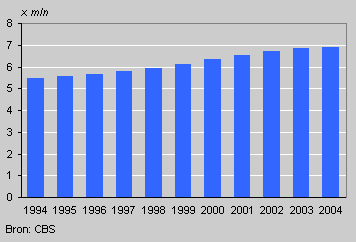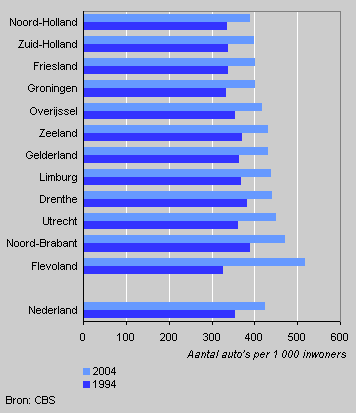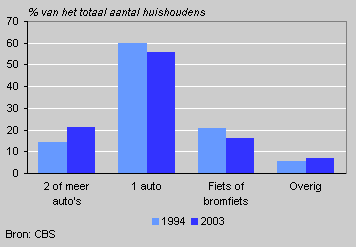One quarter more cars in the space of ten years

More than 6.9 million cars were registered in the Netherlands on 1 January 2004. This means that the total car fleet in the Netherlands has increased by more than a quarter in the space of ten years.
Number of cars

Car density differs regionally
The increase in the number of cars by far exceeds the increase in the population: since 1994 the population has grown by only 5 percent. This means the average car density has also increased. In 1994 there were 356 cars per thousand inhabitants, by the beginning of 2004 this had grown to 425.
Broken down by province, car ownership shows surprising differences. In the provinces North and South Holland there are fewer than 400 cars per thousand inhabitants; in North Brabant on the other hand, there are more than 470.
Car density by province

Two-car households
One of there reasons for the increase in the number of cars is the growing number of households with two or three cars. While only 14 percent of households had two or more cars in 1994, this had risen to 21 percent of households in 2003. Fewer and fewer households do not have a car at all: this share dropped from just over 20 percent in 1994 to 16 percent in 2004.
Households and vehicle ownership

The ownership of second cars is also reflected in the growing number of cars owned by women. While car ownership by men rose by 12 percent in the last ten years, for women this increase was over 45 percent in the same period.
More cars, busier roads
The increase in the car fleet has also resulted in more traffic on Dutch roads. Since 1994 traffic intensity has risen by nearly 28 percent, on motorways even by as much as 32 percent. The growth was highest in the east of the Netherlands, where road traffic increased by 35 percent; the west of the country experienced the lowest growth: 23 percent.
Huub Coninx